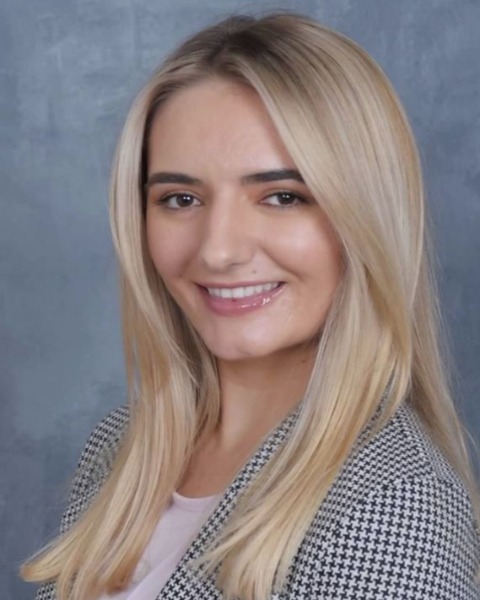Anatomy Education Posters
Poster: Anatomy Education Posters
115 - CN XII Variability in Medical Education
Sunday, March 24, 2024
5:00pm - 7:00pm US EDT
Location: Sheraton Hall
Poster Board Number: 115
There are separate poster presentation times for odd and even posters.
Odd poster #s – first hour
Even poster #s – second hour
Co-authors:
There are separate poster presentation times for odd and even posters.
Odd poster #s – first hour
Even poster #s – second hour
Co-authors:
Alayna Schwartz, OMS III - Burrell College of Osteopathic Medicine; Kris Vaudrey - Rocky Vista University; Miriam Donohue, PhD - Rocky Vista University

Ashley Stiglich
OMS III
BCOM
Tucson, Arizona, United States
Presenting Author(s)
Abstract Body : Introduction: A lack of consistency exists in educating osteopathic medical students on the upper motor neuron (UMN) pathway of the hypoglossal nerve (CN XII) and potential clinical outcomes following UMN CN XII lesions. Cortical fibers of CN XII are often described as descending contralaterally to the hypoglossal nucleus in the caudal medulla where lower motor neurons emerge to innervate ipsilateral tongue muscles. A literature review found four distinct pathways described that could result in variable clinical presentations, in the event of a lesion. This variability in pathways, and potential clinical implications, demonstrates a need for standardizing neuroanatomy curricula available to osteopathic medical students.
Materials/Methods: Thirty-one neurology course syllabi were reviewed from osteopathic medical schools in the United States were available online. Those syllabi listed 27 required or recommended neuroanatomy textbooks.
Twenty-nine United States Medical Licensing Exam (USMLE) Step 1 Board books were reviewed from six “Best USMLE Best Board Prep Resources” websites, including 21 general preparatory books and 8 neurology-specific preparatory books.
Results: The majority of books (n=12) describe a contralateral pathway of UMN CN XII fibers. Of 31 syllabi, 19 had textbooks on their syllabi that described non-exclusively contralateral pathways. Eight USMLE prep books described exclusively contralateral control/contralateral tongue deviation due to an UMN lesion. Four books included some variability, including: one that defined the contralateral deficit as being specific to paralysis of genioglossus, two that mentioned variability in the pathway/tongue deviation and one that included conflicting information (specifically describing only contralateral control in one section but later describing a “predominantly” contralateral innervation indicating partial variability).
Conclusions: Four variations in the UMN pathway of CN XII are described in literature available to osteopathic medical students and have potentially variable clinical outcomes in event of a unilateral lesion. Medical school curricula and board prep books should account for variations in pathways and outcomes.
Significance/Implication: Variations in description of UMN fibers to the hypoglossal nucleus demonstrates need for standardization in curricula including: neuroanatomy curriculum of osteopathic medical schools and board review resources. Lack of standardization impacts student’s approach to board style questions and has clinical relevance as well. There may be inconsistencies in allopathic and advanced practitioner curricula as well, and this should be evaluated in future studies.
Funding Sources: RVU-MCOM purchased 7 books.
Materials/Methods: Thirty-one neurology course syllabi were reviewed from osteopathic medical schools in the United States were available online. Those syllabi listed 27 required or recommended neuroanatomy textbooks.
Twenty-nine United States Medical Licensing Exam (USMLE) Step 1 Board books were reviewed from six “Best USMLE Best Board Prep Resources” websites, including 21 general preparatory books and 8 neurology-specific preparatory books.
Results: The majority of books (n=12) describe a contralateral pathway of UMN CN XII fibers. Of 31 syllabi, 19 had textbooks on their syllabi that described non-exclusively contralateral pathways. Eight USMLE prep books described exclusively contralateral control/contralateral tongue deviation due to an UMN lesion. Four books included some variability, including: one that defined the contralateral deficit as being specific to paralysis of genioglossus, two that mentioned variability in the pathway/tongue deviation and one that included conflicting information (specifically describing only contralateral control in one section but later describing a “predominantly” contralateral innervation indicating partial variability).
Conclusions: Four variations in the UMN pathway of CN XII are described in literature available to osteopathic medical students and have potentially variable clinical outcomes in event of a unilateral lesion. Medical school curricula and board prep books should account for variations in pathways and outcomes.
Significance/Implication: Variations in description of UMN fibers to the hypoglossal nucleus demonstrates need for standardization in curricula including: neuroanatomy curriculum of osteopathic medical schools and board review resources. Lack of standardization impacts student’s approach to board style questions and has clinical relevance as well. There may be inconsistencies in allopathic and advanced practitioner curricula as well, and this should be evaluated in future studies.
Funding Sources: RVU-MCOM purchased 7 books.

